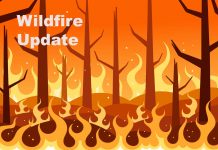By BILL HARRIS
Ryan McMahon knows that his four-part original investigative docuseries THUNDER BAY is going to elicit strong reactions. “We’re talking about fighting for something better in this country,” said McMahon, the Anishinaabe journalist who produced, wrote, and co-directed THUNDER BAY. “We’re talking about fighting for these families, and these children that died. We don’t want another young person to die at the hands of violence. We’re just asking that people consider: what can be better than what we have? So yeah, I’m looking forward to the response.”
Based on the groundbreaking podcast from CANADALAND, and debuting Friday, Feb. 17 on Crave, THUNDER BAY follows McMahon on his continued quest to uncover the truth behind the deaths of numerous Indigenous people in Thunder Bay, Ont., which historically has experienced high rates of homicides and hate crimes.
McMahon spoke about the tragic story, and the making of the docuseries, in a conversation with
The Lede: Q: You refer to Thunder Bay as a unique intersection between Indigenous and non-Indigenous people. Can you explain that a bit more?
McMAHON: “Thunder Bay geographically is, by global standards, in the middle of nowhere. The nearest major city to the east is Sault Ste. Marie, and the nearest major city to the west is Winnipeg. So everyone in between needs to decide, you know, where they want to go to shop, or see a show. Thunder Bay just happens to be a bit of a regional hub. These regional hubs exist all through Canada – places like Prince Albert, Sask., or Timmins, Ont. These Northern towns have that intersection, and why there is sort of a collision, I think, is that we just haven’t figured out what our relationship is yet, between Indigenous and non-Indigenous people, writ large in these kinds of towns and cities.”
Q: One of the striking factors you point out in the doc is how many Indigenous kids have to leave their remote Northern communities to go to high school in Thunder Bay.
McMAHON: “It happens at all ages – some parents decide that they want a better education for their kids in grade school, and they’ll leave the reserve and relocate their families to the closest town or city they can find. But for our story, we focused on kids leaving their communities to go to high school. Where I have a bit of compassion and empathy for Thunder Bay, having told this story for the last few years, is that Thunder Bay is not the only place this happens. But it is the place where a disproportionate number of unsolved deaths and murders happen.”
Q: What was the biggest challenge of essentially transforming a podcast into a TV docuseries that had to be told visually as well as vocally?
McMAHON: “Yeah, the leap was difficult. This material is difficult to work with. When I think about pointing cameras at people that are grieving, pointing cameras at people in their worst moments, pointing cameras at people that are so desperate for change, are they willing to go on camera to once again share their loved ones’ stories, and share their loss? It becomes a question of lens: who is this story for? As Indigenous people, we are familiar with these traumas, we’re familiar with grief and loss. So how do I make something that is not simply surface-based – what some refer to as ‘trauma porn’ – where we just dip the viewer into the trauma and push them out into the world? So it was an incredible challenge. We filmed as this story broke. We worked with private investigators, and we worked with researchers, and our sources that we gained through the making of the podcast. We chased the ball live in real time. But through four episodes, I think it really pays off.”
Q: Were you surprised how willing people were to talk about things when you showed up with cameras, or did you have to do a lot of convincing?
McMAHON: “I was very surprised at how willing people were to share. And I was surprised at how willing sources were to jump in the boat, once they found out what we were doing. This is a documentary series shot in a big town, that is just barely a city, that was very familiar with the podcast, and very familiar with my work, and how I work. Quite frankly, when eOne (Entertainment One) said that Bell Media and Crave had optioned it, I thought, ‘there’s not a chance this documentary series gets made – like, do they know how mad people are at me in that city?’ But when we went back to the city with cameras, people were desperate to share. It just goes to show you how much work is left to do. And we were on the ground at the exact right time. Our impulses, and my impulse as a director, as a filmmaker and a writer, were correct, thankfully. And to Bell’s credit, and to eOne’s credit, they let me see this through, until we got, I think, a solution that very few people will expect. Hopefully we will have done something really important with this journalism, that calls for better, for everyone.”






